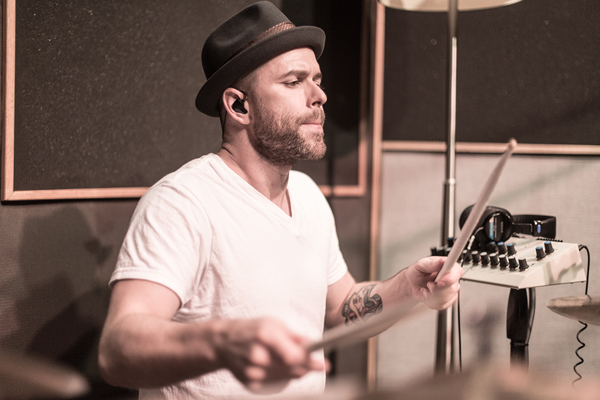Capturing drums can be one of the most challenging aspects of the recording process. For one thing, there are so many pieces in the average kit that need to be mic’d. And they take up so much room. And they are so loud. And they have to be performed perfectly. And they are hard to edit if the drummer makes a mistake. Starting to get the picture? Damn drummers!
[editor’s note – see last month’s issue or head here for Part One in our series on recording drums.]
You’ll want to set up a matching pair of condenser mics in either an X-Y or ORTF pattern a few feet in front of the drum kit and usually about 6-7 feet off the ground to capture the kit as a whole (check out YouTube videos on these stereo setups if you’re not familiar or go back and read our previous article on stereo miking techniques in Performer). If the room sounds good and the mics are placed properly, then these stereo mics will often capture the cymbals quite well without the need for separate cymbal mics.
Close miking cymbals generally doesn’t work well, as cymbals are designed to be heard from at least a few feet away. Plus, with all the close miking of the other drum pieces, the overall mix can sound a little dead, so using the overhead mics to capture the room sound can breathe some life into your drum mix.
DAMPENING DOs
We often use dampening gel like RTOM Moongel ($8), which are little blue pieces of semi-sticky gum that you apply to the outer edge of the top heads of the snare and toms. This easily helps reduce unwanted boominess and overtones. But in a pinch, maxi pads or folded up paper towels taped to the heads with console tape or blue painters tape work well, too (it just doesn’t look as cool).
TIGHT TO FIT
Make sure that your drum and percussion tracks are tight. If you recorded to a metronome, this means taking the time to solo playback each track with the click and edit any “loose” hits. Remember that if you edit a hit on a close mic track, you also have to move any room mic tracks that captured the hit as well. If you didn’t record to a click, the job becomes a bit harder because you won’t have a reference, so in this case you’ll probably want to dim solo the drum track so that you can still hear the other rhythm instruments.
Don’t be fooled into thinking the drums are wrong if another rhythm instrument is actually the culprit. Also look for timing issues around drum fills and changes in the song; this is generally where drummers tend to speed up temporarily.
SHAKE IT UP!
One of the most enjoyable parts of the session for us is after a song has been rough mixed and we break out the percussion basket. The band gathers around and everyone starts slapping, shaking and tapping the mixture of familiar and foreign percussion instruments that we’ve collected over the years – cabasas, tambourines, shakers big & small, agogos, güiros, triangles, slide whistles, claves, wood blocks, washboards and so forth.
The biggest hurdle we usually have is to get musicians into the mindset that it’s “okay to experiment.” What sounds like “too much” when trying out a percussion instrument in the control room can be mixed and edited so that it just adds a subtle sonic texture during certain sections of the song. Think of percussion like a spice. Too much and the meal is inedible, too little and food is bland. You’d be surprised how often a little bit of shaker or tambourine can add an interesting flavor to a track.
I urge you to check out the percussion section the next time you visit your local music store and see if you can’t find an instrument that intrigues you. Also percussion manufactures like LP (Latin Percussion) and Meinl have great videos on their YouTube channels of many percussion instruments being played by pros for your inspiration
Our advice is to record a part over the sections that you think need an extra lift or excitement and then mix this new percussion track down and to the side. If you mix it low enough so that it’s barely noticeable right after you tracked it, then when you come back with fresh ears you might be surprised that you don’t notice it at all. Percussion tracks can do well when panned hard left or right, and can help open up a mix in the stereo field and add textural interest at the same time.
ABOUT THE AUTHORS
Zac Cataldo is a musician and owner/producer at Night Train Studios, a recording studio in Westford, MA. He is also co-owner of Black Cloud Productions, a music publishing company. Reach him at zac@nighttrainstudios.com.
Brent Godin is a bassist/guitarist and engineer/producer at Night Train Studios. He is also a talent scout at Black Cloud Productions. Reach him at brent@blackcloudproductions.com.
